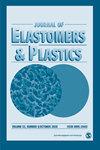Preparation and Properties of Polyurethanes based on Castor Oil Chemically Modified with Yucca Starch Glycoside
IF 1.6
4区 材料科学
Q4 MATERIALS SCIENCE, MULTIDISCIPLINARY
引用次数: 31
Abstract
We present novel polyurethanes from renewable materials of castor oil and starch. Castor oil is transesterified with pentaerythritol in order to obtain a wide range of polyols. Yucca starch is converted into glycoside through transglycosylation reactions with ethylene glycol and glycerol. The glycosides from starch are then chemically incorporated to the castor oil polyols by a second transesterification reaction to generate a sequence of polyol-glycosides with a high level of polyhydroxyl content. These products are characterized by the hydroxyl value, viscosity, and specific gravity as a function of the glycoside type content and the kind of castor oil polyol prepared. MALDI TOF mass spectroscopy is used to find the mass fraction of glycosides and polyol-glycosides. Polyurethanes are synthesized from the polyol-glycosides by reaction with isophorone diisocyanate, under different NCO/OH molar ratios. The polymer characterization is accomplished by Fourier transform infrared analysis, tensile stress—strain tests, Shore A hardness, thermogravimetric analysis, chemical resistance to solvents, scanning electron microscopy, and dynamic-mechanical thermal analysis.丝兰淀粉苷化学改性蓖麻油聚氨酯的制备及性能研究
我们提出了一种新型聚氨酯从蓖麻油和淀粉的可再生材料。蓖麻油与季戊四醇酯交换得到多种多元醇。丝兰淀粉通过与乙二醇和甘油的转糖基化反应转化为糖苷。然后通过第二次酯交换反应将淀粉中的糖苷化学地掺入蓖麻油多元醇中,生成一系列具有高水平多羟基含量的多元醇糖苷。这些产品的特点是羟基值,粘度和比重作为糖苷类型含量和蓖麻油多元醇的种类的函数。用MALDI TOF质谱法测定了糖苷和多元醇糖苷的质量分数。在不同的NCO/OH摩尔比下,由多元醇苷与二异氰酸酯异佛酮反应合成聚氨酯。聚合物的表征是通过傅里叶变换红外分析、拉伸应力应变测试、邵尔A硬度、热重分析、耐溶剂化学性能、扫描电子显微镜和动态机械热分析来完成的。
本文章由计算机程序翻译,如有差异,请以英文原文为准。
求助全文
约1分钟内获得全文
求助全文
来源期刊

Journal of Elastomers and Plastics
工程技术-材料科学:综合
CiteScore
3.30
自引率
5.90%
发文量
41
审稿时长
6 months
期刊介绍:
The Journal of Elastomers and Plastics is a high quality peer-reviewed journal which publishes original research on the development and marketing of elastomers and plastics and the area in between where the characteristics of both extremes are apparent. The journal covers: advances in chemistry, processing, properties and applications; new information on thermoplastic elastomers, reinforced elastomers, natural rubbers, blends and alloys, and fillers and additives.
 求助内容:
求助内容: 应助结果提醒方式:
应助结果提醒方式:


